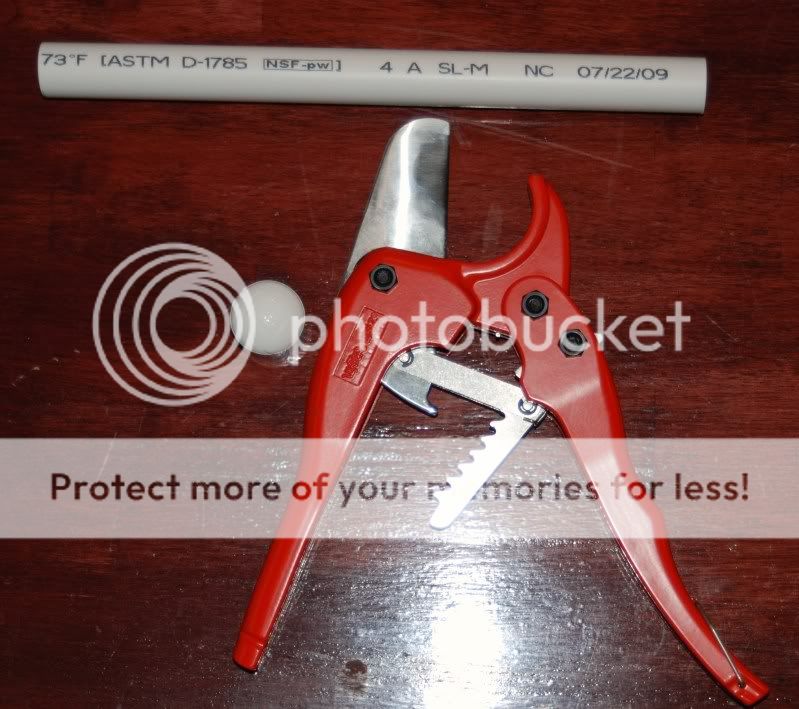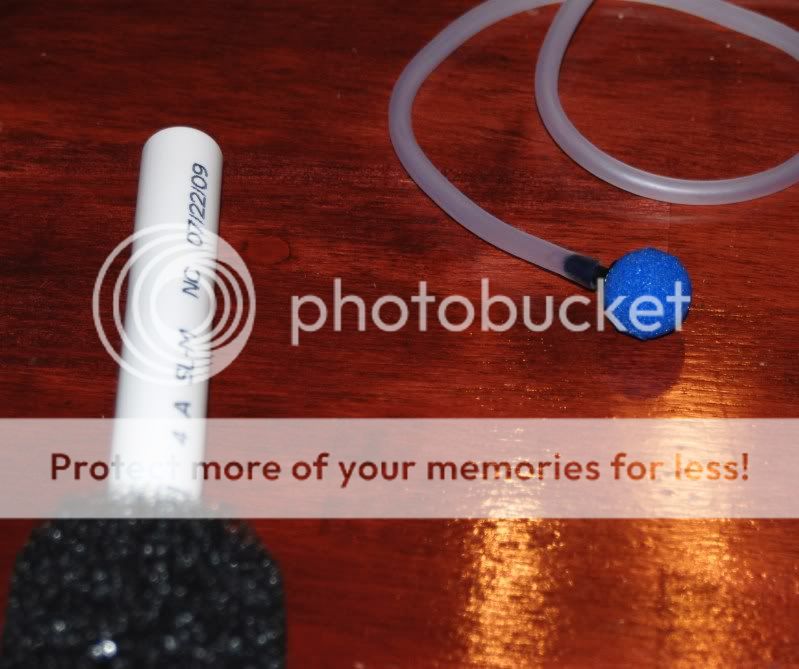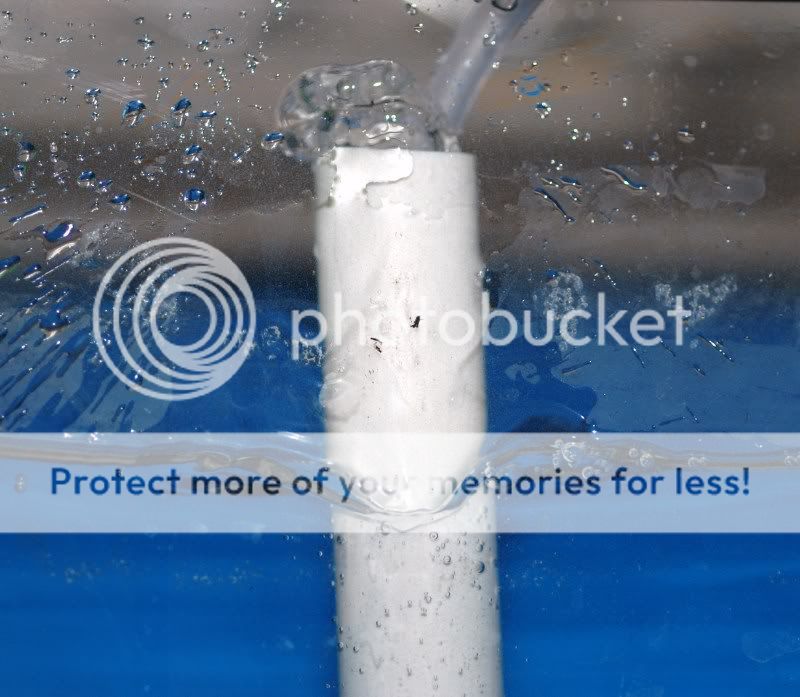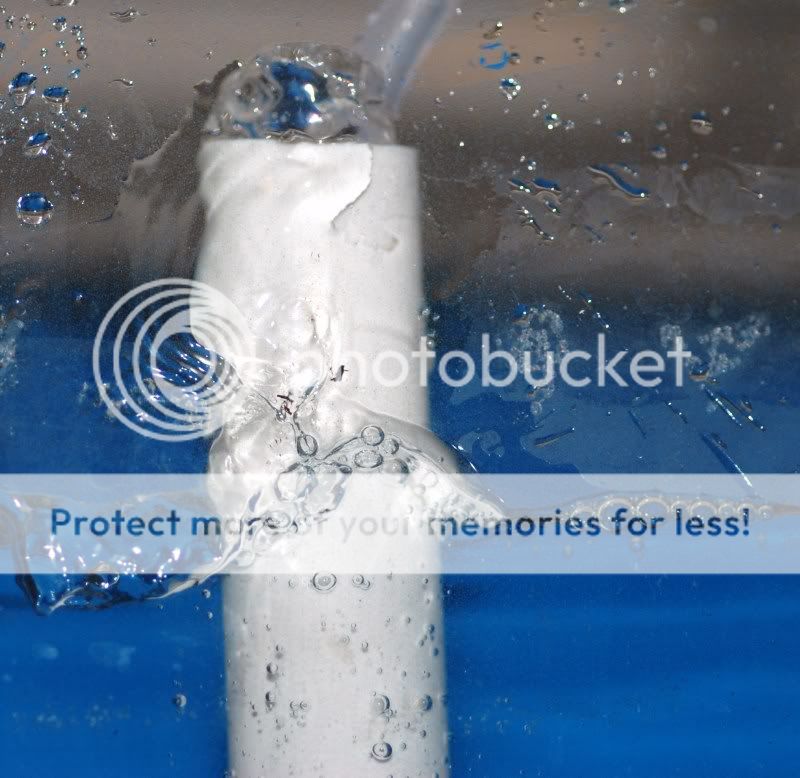Here's a list of things you'll need:
PVC (or CPVC if that's what you prefer)
end caps to fit the diameter of PVC you are using
aquarium safe silicone
type of sponge (we'll get to the different kinds you can use in a bit)
a PVC cutter, a hacksaw, or a really sharp knife
an electric drill or a bench top drill
safety goggles
file or sand paper to clean PVC one done drilling
air hose
air pump
First and foremost, cut the PVC to your desired length.
For my application, we were making these for a 10 gallon which is 12 inches tall. We determined that a 10 inch pipe would work. We bought 1/2" PVC in a 5 foot length for 93 cents. This gave us 6 10" peices. We purchased a 10 pack of end caps for $2.53.

I marked the pipe every 10 inches and used a PVC cutter. I checked them out at Lowes and they were about $30. I had one from a previous project so if you don't want to spend the money, you could a hacksaw, a sharp boxcutter, a sharp steak knife, whatever you have available. I've also used the PVC cutter to cut hoses for my canister so it's definitely worth the investment in my eyes.
Next we drilled holes in the PVC using a bench drill. You could use a hand held electric drill but just be EXTREMELY careful of fingers and clamp it to a work table if available. The cap we used is approximately 1 inch in height so we started one inch up from the end. The sponge we'd be using was a little over 2 1/2 inches tall so I made sure to not go over that measurement. I had no rhyme or reason for where I drilled the holes or how many I drilled. I chose the bit so it was large enough to not get clogged easily but not too large. I made sure to put in enough holes to get good flow thru them.

Next, we used a file to clean up the inside, outside and individual holes we drilled.
Now is the time to silicone the end cap onto your drilled pipe. We used GE1 silicone but you can always spend more money and use the same thing labeled as aquarium silicone.

After giving the cap and end of pipe a good rinse and wipe down, I squirted the inside edges of the cap with silicone.

I then put then cap on using a twisting motion to smooch the silicone around and get a good seal.

The PVC and cap I used were pretty heavy with thick walls. If the PVC you are using is less in weight, you might want to think about achoring your pipe by siliconing the assembly to a peice of slate or putting some type if weight on the inside of the cap before siliconing it to the pipe.
Now is the time to put on your sponge. There are many different kinds you can use. For my specific project, I used the Penguin reverse flow kit replacement sponge.

It measure 5 3/4 of an inch tall but we cut it in half. For a smaller tank or even a small bioload, you could even cut it in thirds.

The price for this replacement is $3.49 or $3.09 for 3+ at pet solutions. Other products you can use are bonded filter pad that you can cut in strips and wrap around the pipe securing with elastics or zip ties.

Another idea is to buy blocks of sponge filter material that you can sometimes find at petstores and cut it to your dimensions and cut a hole the the middle.
Now that you have your sponge material prepped, just slide it onto the pipe and over the holes you've drilled.

Be sure to cover your holes you've drilled. You can even cover the end cap if you'd like or you can leave it open like we did.

Not is the time to feed the airtube down the pipe with or without the air stone (personal preference)

One thing you can add at this point is an elbow to the top if you'd like to direct the flow of water coming from the top of the pipe. You could drill a hole large enough for the air tube to be fed down into the pipe or use a peice of rigid air tube. I would however not silicone the elbow to the top.

Now it's time to throw it in the tank and turn it on.


It works!
PVC (or CPVC if that's what you prefer)
end caps to fit the diameter of PVC you are using
aquarium safe silicone
type of sponge (we'll get to the different kinds you can use in a bit)
a PVC cutter, a hacksaw, or a really sharp knife
an electric drill or a bench top drill
safety goggles
file or sand paper to clean PVC one done drilling
air hose
air pump
First and foremost, cut the PVC to your desired length.
For my application, we were making these for a 10 gallon which is 12 inches tall. We determined that a 10 inch pipe would work. We bought 1/2" PVC in a 5 foot length for 93 cents. This gave us 6 10" peices. We purchased a 10 pack of end caps for $2.53.

I marked the pipe every 10 inches and used a PVC cutter. I checked them out at Lowes and they were about $30. I had one from a previous project so if you don't want to spend the money, you could a hacksaw, a sharp boxcutter, a sharp steak knife, whatever you have available. I've also used the PVC cutter to cut hoses for my canister so it's definitely worth the investment in my eyes.
Next we drilled holes in the PVC using a bench drill. You could use a hand held electric drill but just be EXTREMELY careful of fingers and clamp it to a work table if available. The cap we used is approximately 1 inch in height so we started one inch up from the end. The sponge we'd be using was a little over 2 1/2 inches tall so I made sure to not go over that measurement. I had no rhyme or reason for where I drilled the holes or how many I drilled. I chose the bit so it was large enough to not get clogged easily but not too large. I made sure to put in enough holes to get good flow thru them.

Next, we used a file to clean up the inside, outside and individual holes we drilled.
Now is the time to silicone the end cap onto your drilled pipe. We used GE1 silicone but you can always spend more money and use the same thing labeled as aquarium silicone.

After giving the cap and end of pipe a good rinse and wipe down, I squirted the inside edges of the cap with silicone.

I then put then cap on using a twisting motion to smooch the silicone around and get a good seal.

The PVC and cap I used were pretty heavy with thick walls. If the PVC you are using is less in weight, you might want to think about achoring your pipe by siliconing the assembly to a peice of slate or putting some type if weight on the inside of the cap before siliconing it to the pipe.
Now is the time to put on your sponge. There are many different kinds you can use. For my specific project, I used the Penguin reverse flow kit replacement sponge.

It measure 5 3/4 of an inch tall but we cut it in half. For a smaller tank or even a small bioload, you could even cut it in thirds.

The price for this replacement is $3.49 or $3.09 for 3+ at pet solutions. Other products you can use are bonded filter pad that you can cut in strips and wrap around the pipe securing with elastics or zip ties.

Another idea is to buy blocks of sponge filter material that you can sometimes find at petstores and cut it to your dimensions and cut a hole the the middle.
Now that you have your sponge material prepped, just slide it onto the pipe and over the holes you've drilled.

Be sure to cover your holes you've drilled. You can even cover the end cap if you'd like or you can leave it open like we did.

Not is the time to feed the airtube down the pipe with or without the air stone (personal preference)

One thing you can add at this point is an elbow to the top if you'd like to direct the flow of water coming from the top of the pipe. You could drill a hole large enough for the air tube to be fed down into the pipe or use a peice of rigid air tube. I would however not silicone the elbow to the top.

Now it's time to throw it in the tank and turn it on.


It works!


